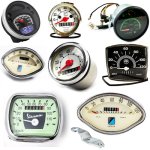billyjones454
100 mW
- Joined
- Feb 16, 2011
- Messages
- 44
I love the idea of having some vintage looking analog dials on an ebike, giving information like Speed, Temp, Voltage, (battery capacity?)etc...

I don't really know how to do that, however I did find this cool youtube video of someone taking an analog voltmeter and converting it to a temperature sensor with the help of an arduino.
Has anyone tried this before? What about using stepper motors for a 360 degree sweep?
[youtube]5OQXyVQmN08[/youtube]

I don't really know how to do that, however I did find this cool youtube video of someone taking an analog voltmeter and converting it to a temperature sensor with the help of an arduino.
Has anyone tried this before? What about using stepper motors for a 360 degree sweep?
[youtube]5OQXyVQmN08[/youtube]





